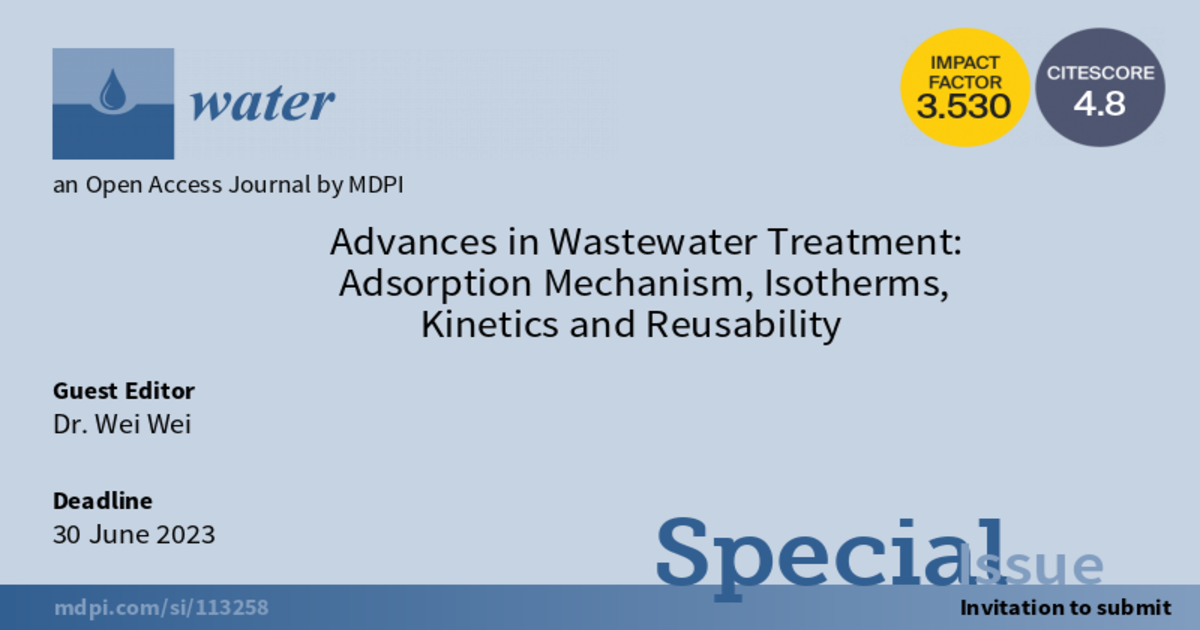Advances in Wastewater Treatment: Adsorption Mechanism, Isotherms, Kinetics and Reusability
A special issue of Water (ISSN 2073-4441). This special issue belongs to the section "Wastewater Treatment and Reuse".
Deadline for manuscript submissions: closed (30 June 2023) | Viewed by 20330

Special Issue Editor
Interests: water and soil remediation; environmental functional materials; colloid and interface science; apatite materials; biochar; potential toxic metals; emmergent contaminants; fate and transport of nanomaterials/nanoplastics
Special Issues, Collections and Topics in MDPI journals
Special Issue Information
Dear Colleagues,
Water is an essential part of life, and its availability is very important for all living creatures. However, increased industrialization and the excessive use of toxic chemicals have caused severe water contamination problems. Globally, about 359 billion cubic metres of wastewater is produced each year. The wastewater must be treated before being discharged into a waterbody. Nowadays, there is a continuously increasing worldwide concern regarding the development of more effective techniques for wastewater treatment. Particularly, adsorption has long been considered to be a readily available technology for the treatment of wastewater due to its high efficiency, low cost, flexible design, ease of operation, and the possibility of reusing its adsorbent. During recent decades, great efforts have been devoted to the application of adsorption technology for water/wastewater treatment, which have achieved significant results in adsorption performances, models and mechanisms. However, the growing number of novel adsorbents and aqueous contaminants make adsorption processes more complicated with respect to adsorption mechanisms, isotherms and kinetics. Furthermore, the development of low-cost, highly efficient, and reusable adsorbents has led to the rapid growth of research interests in this field.
This Special Issue aims to provide selected contributions on the wastewater treatment process by adsorption technology using various adsorption processes. I warmly invite researchers to contribute original research articles as well as review articles that address adsorption mechanisms, isotherms, kinetics and reusability in wastewater treatment.
Dr. Wei Wei
Guest Editor
Manuscript Submission Information
Manuscripts should be submitted online at www.mdpi.com by registering and logging in to this website. Once you are registered, click here to go to the submission form. Manuscripts can be submitted until the deadline. All submissions that pass pre-check are peer-reviewed. Accepted papers will be published continuously in the journal (as soon as accepted) and will be listed together on the special issue website. Research articles, review articles as well as short communications are invited. For planned papers, a title and short abstract (about 100 words) can be sent to the Editorial Office for announcement on this website.
Submitted manuscripts should not have been published previously, nor be under consideration for publication elsewhere (except conference proceedings papers). All manuscripts are thoroughly refereed through a single-blind peer-review process. A guide for authors and other relevant information for submission of manuscripts is available on the Instructions for Authors page. Water is an international peer-reviewed open access semimonthly journal published by MDPI.
Please visit the Instructions for Authors page before submitting a manuscript. The Article Processing Charge (APC) for publication in this open access journal is 2600 CHF (Swiss Francs). Submitted papers should be well formatted and use good English. Authors may use MDPI's English editing service prior to publication or during author revisions.
Keywords
- adsorption in water
- batch adsorption
- column adsorption
- nanomaterials
- natural and synthetic adsorbents
- mineral adsorbents
- biochar adsorbents
- carbon adsorbents
- iron based adsorbents
- water and wastewater treatment





